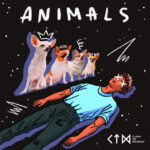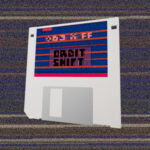Silvurdrongur, the Faroese multidisciplinary artist and leading force behind the critically acclaimed band AGGRASOPPAR, returns with his latest experimental concept album, nú æt eg eftir ánni (Now I Was Named After the River). Released on July 17th via Tutl Records, this album represents a daring exploration of the boundaries between electronic music and the folklore of the Faroe Islands, offering a truly unique auditory experience.
The album title, which is performed entirely in Faroese—a language spoken by only around 50,000 people—immediately sets the tone for the journey ahead. The title itself is a poetic reference, hinting at the deep connection between the music and the natural world. Each track is named after a mythical or symbolic creature associated with the riverbank, creating an overarching narrative that guides the listener through this dark and otherworldly soundscape.
Silvurdrongur’s ability to blend genres is nothing short of masterful. From the hauntingly minimalistic beats to the distorted, industrial basslines, nú æt eg eftir ánni blurs the lines between what we traditionally categorize as music genres. The album’s sound has been described as ‘Extinction Punk’, ‘Doomer Pop’, and ‘Haunted Club’, and these terms capture the eerie, melancholic, yet strangely captivating vibe that permeates each track.
The rhythmic structure of the album is particularly striking. Tracks like “Sóljudrongur” and “Spælidrongur” open with syncopated beats that feel disjointed at first but gradually coalesce into hypnotic patterns. The rhythm section isn’t just a backdrop here—it’s an integral part of the narrative, evoking the rhythmic flow of a river while also conveying a sense of unease, as if the ground beneath you is shifting.
The basslines, too, are worthy of note. In “Brúðardrongur” and “Pínudrongur,” the bass is deep and resonant, anchoring the tracks with a weighty presence that contrasts beautifully with the lighter, more ethereal elements of the music. The bass isn’t just a pulse; it’s a character, embodying the dark, brooding nature of the river’s depths, and providing a foundation for the album’s more experimental sounds to build upon.
One of the most compelling aspects of nú æt eg eftir ánni is how it manages to maintain a coherent narrative while exploring such diverse sonic territory. The album is structured like a dark fairy tale, guiding the listener through the shadows of the Faroese forest. Tracks like “Shamandrongur” and “Devladrongur” incorporate elements of traditional Faroese music, but these are twisted and distorted, becoming almost unrecognizable in their new context. This is music that challenges the listener, demanding full attention to appreciate the layers of meaning and sound woven throughout.
Visually, the album is complemented by a stunning artistic presentation. The cover art, featuring Gwenael A. Helmsdal’s photography and illustrations by Mikkjal á Ryggi, adds another layer of depth to the experience, grounding the music in a rich visual context that enhances the album’s themes of extinction, transformation, and the eerie beauty of the natural world.
In conclusion, nú æt eg eftir ánni is a groundbreaking album that defies easy categorization. Silvurdrongur has created something truly unique—a blend of electronic experimentation and folkloric storytelling that feels both timeless and utterly contemporary. It’s a journey worth taking, and we’re thrilled to host this review on our webzine.






